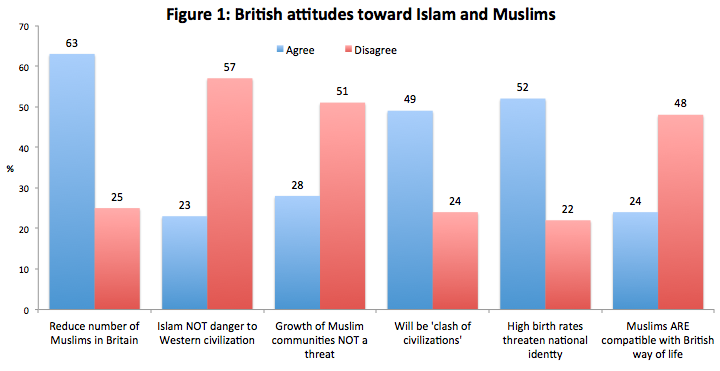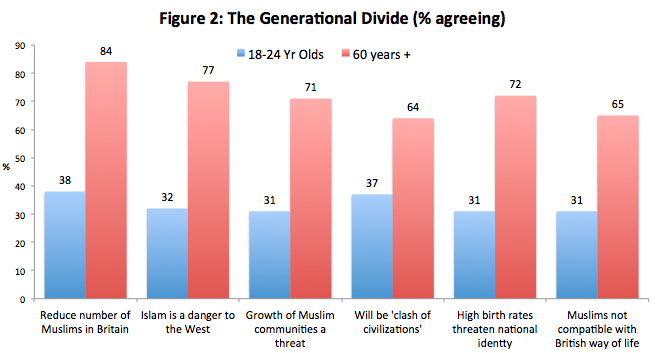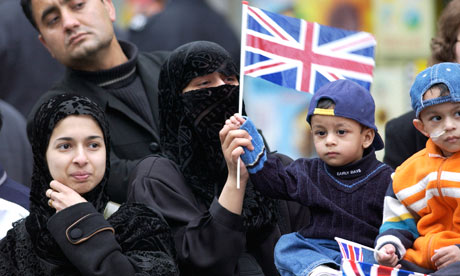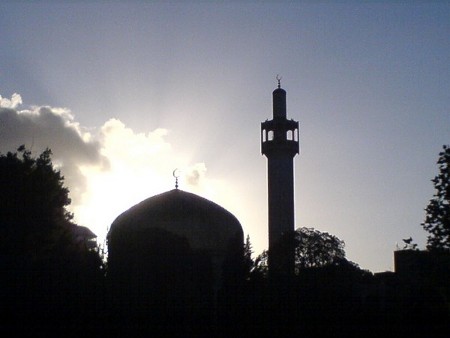by
Syarif Hidayat
In
spite of Islamophobia is still
prevailing in the Western world, Islam is the fastest growing religion in the
West especially in the United Kingdom and Britain has a chance to have a Muslim
majority by 2050.
John Bingham in his article titled “Study
shows Islam growing, Christianity declining in the UK” writes a new analysis of the 2011 census shows that a decade
of mass immigration helped mask the scale of decline in Christian affiliation
among the British-born population – while driving a dramatic increase in Islam,
particularly among the young. It suggests that only a
minority of people will describe themselves as Christians within the next
decade, for first time.
The proportion of young people who describe themselves as even nominal
Christians has dropped below half for the first time.
Initial results
from the 2011 census published last year showed that the total number of people
in England and Wales who described themselves as Christian fell by 4.1 million
– a decline of 10 per cent.
But new
analysis from the Office for National Statistics shows that that figure was
bolstered by 1.2 million foreign-born Christians, including Polish Catholics
and evangelicals from countries such as Nigeria.
They disclosed
that there were in fact 5.3 million fewer British-born people describing
themselves as Christians, a decline of 15 per cent in just a decade.At the same
time the number of Muslims in England and Wales surged by 75 per cent – boosted
by almost 600,000 more foreign born followers of the Islamic faith.
While almost
half of British Muslims are under the age of 25, almost a quarter of Christians
are over 65. The average age of a British Muslim is just 25, not far off half that of a
British Christian.
Younger people
also drove a shift away from religion altogether, with 6.4 million more people
describing themselves as having no faith than 10 years earlier.
Secular
campaigners said the new figures showed that Christianity had now dropped below
“critical mass” making the case for disestablishing the Church of England
stronger. But the Church insisted that while there had been a significant drop in
“nominal” Christians, the core of the Church remained firm.
Prof David
Coleman, Professor of demography at Oxford University, said: “This is a very
substantial change – it is difficult to see whether any other change in the
census could have been remotely as big.
“But I wonder
how far it reflects an overarching change in society where it is more
acceptable more normal to say that you are not religious or are not Christian.”
Dr Fraser
Watts, a Cambridge theologian, said it was “entirely possible” the people
identifying themselves as Christians could become a minority within the next
decade on the basis of the figures.
“It is still
pretty striking and it is a worrying trend and confirms what anyone can observe
– that in many churches the majority of the congregation are over 60,” he said.
Keith Porteous Wood,
executive director of the National Secular Society, said the long-term
reduction of Christianity, particularly among young people, was now
“unstoppable”. “In another 20 years there are going to be more active Muslims than there
are churchgoers,” he said.
“The time has
now come that institutional Christianity is no longer justified, the number has
dropped below critical mass for which there is no longer any justification for
the established Church, for example, or the monarch going through a religious
ceremony at coronation.
“The
expressions of optimism by the church are just completely misplaced.”
But a spokesman
for the Church of England said: “These figures highlight the diversity of
Christianity in this country today, something which has been increasing for
decades and shows the relevance of Christianity to people from all backgrounds.
“These figures
once again confirm that this remains a faithful nation and that the fall in the
numbers identifying themselves as Christians is a challenge but – as you can
see from the stability of Church of England attendance figures – the committed
worshipping centre of the church remains firm.
The
claim
“By
the year 2050, in a mere 37 years, Britain will be a majority Muslim nation.” - Vincent Cooper, June 13 2013
The
background
Patrick Worrall is his
article titled: “FactCheck: will Britain have a Muslim majority by 2050?” writes We don’t normally FactCheck other
journalists, mainly because there’s enough spin from politicians to keep us
busy. But readers have asked for our
take on a piece published on the Commentator website, which has generated a lot
of online interest.
Vincent Cooper’s article, which has
apparently attracted 2,600 “likes” on Facebook, suggests that birth rates among
Muslims are much higher than among “native Europeans”.
The result is that, less than 40 years
from now, the sound of church bells will apparently have been largely replaced
by the Muslim call to prayer. The
article says it is based on “demographic facts”. What are the facts?
The
analysis
There were 1.6 million Muslims in
England and Wales in 2001, or 3 per cent of the population, according to the
census. By 2011 the Muslim population had grown to 2.7 million people or 4.8
per cent of the population.
So there’s no doubt that the number of
people who identify themselves as Muslims has grown rapidly in recent years.
We’ve tried to phrase that carefully,
because most measures of population (the census, the Labour Force Survey) rely
on people describing themselves as members of certain religious and ethnic
groups, and people’s attitudes about how they identify themselves can change.
The Muslim population of Eastern
European countries appeared to soar between 1990 and 2000, but the most likely
explanation is that the population didn’t really grow – it’s just people felt
more comfortable about identifying themselves as Muslim after the collapse of
the communist system, in which religious self-expression was discouraged.
Similarly, some commentators have
suggested that part of the apparent leap in the number of Muslims in England
and Wales can be explained by a reaction to the “war on terror” and a growing
willingness for people to claim Muslim identity.
The Muslim Council of Britain has said
that the 2001 figure was an underestimate, because Muslims were reluctant to
identify themselves as such at the time.
Nevertheless, it seems likely there has
been a real increase in the Muslim population of Britain, due to a mixture of
immigration and higher birth rates.
Mr Cooper concentrates on the issue of
birth rates, and basically suggests that if fertility among Muslim women
continues to be higher than other demographic groups, then extending current
trends into the future will give us a Muslim majority by 2050.
That flies in the face of evidence which
shows that, while fertility rates have historically been significantly higher
among Muslims, birth rates are now dropping among Muslim immigrant populations
in Europe and in Muslim countries.
Summary
While it is true that Muslim birth rates
are currently higher than non-Muslims, current data suggest that it will not
remain constant and that the gap will decrease. So while it is certain that
there will be an increase in the number of Muslims due to higher birthrate the
claim that Muslims will be the
“majority” in Britain by 2050 lacks evidence.
Ross
Macmillan in his article titled: “Record breaking:
100,000 Muslim converts living in UK, and rising” publish in January 5, 2011 in 24 Dash, wrote Up to 100,000 converts to Islam are
living in the UK, with white women leading the growing number of people
embracing the Muslim faith, according to a report published today.
The number of converts to Islam may
have risen from around 60,000 in 2001 to up to 90,000 to 100,000, according to
estimates in a report for the Faith Matters organisation. A study by Kevin
Brice, of Swansea University, on behalf of Faith Matters, found 5,200 people
converted to Islam in the UK last year.
A survey of 122 converts last year
showed 56% were white British, with women making up 62% of respondents. The
average age at conversion was just over 27.
The majority reported difficulties after
converting because of the negative attitude of their family, but over time this
attitude became more “positive” according to the report.
The majority of the converts saw
themselves as both British and Muslim and did not feel disillusioned with
British society and culture.
But they also felt their own
lives had been “lost” and were “lacking in purpose” before conversion, and
feared that there was a “normalisation” of “immoral” behaviour amongst an
increasingly less religious British public.
Only a very small minority saw
celebrating birthdays, listening to music or reading fiction as prohibited by
Islam, with fewer than 10% viewing attending a family Christmas dinner as
forbidden.
A majority said that most or all of their
close friends were Muslims but almost all felt that Muslims should not keep
themselves separate from non-Muslims.
The vast majority of women had changed
their appearance after conversion, with a significant majority adopting the
hijab, or head scarf.
But the survey showed that the majority
of converts disagreed with the niqab, or face veil, in spite of supporting the
right of women to wear it. “Converts do not represent a devious fifth column
determined to undermine the Western way of life – this is a group of normal
people united in their adherence to a religion which they, for the most part,
see as perfectly compatible with Western life,” the report said.
“Converts are generally at ease living
in the UK and do not feel that British people are essentially hostile to Islam.”
The findings have been released after Lauren Booth, sister-in-law of former
Prime Minister Tony Blair, attracted widespread publicity when she announced
last year that she had converted to Islam.
Faith Matters director Fiyaz Mughal
said: “Conversion to Islam has been stigmatised by the media and wrongly
associated with extremist ideologies and discriminatory cultural practices.
“Converts have an important role to
play in supporting community cohesion, and it is vital that mosques can support
them to encourage greater understanding amongst non-Muslims.”
According to The Economist article titled: “Muslim education in Britain: living together, or
separately” , IT IS
not easy to plan or regulate the education of children in an area where culture
and demographics are shifting rapidly. There can be few places in Europe where
that dilemma is felt so acutely as it is in Bradford, a declining industrial
city in the north of England. Very nearly a quarter of the 523,000 people
living within its municipal boundaries are Muslim, according to the 2011
census. That is a rise of eight percentage points over the past decade, while
the self-declared Christian share of the population has fallen over the same
period from 60% to 46%.
A high proportion of Bradford’s Muslim
population has family roots in south Asia, and in many cases they come from
rural areas of Kashmir, where social and family mores are conservative even by
the standards of the Islamic world. Just as they would back home, Asian Muslim
parents in Bradford attach overwhelming importance to the instruction of their
children in at least the basics of Islamic belief and practice. About 9,000
children in Bradford top up their regular state school education with at least
an hour of instruction at a madrassa or religious school, several days a week;
possibly 1,000 or more attend independent Muslim schools where they receive
their entire education through a Muslim prism.
This week the Bradford Council of
Mosques, representing 80 or so places of Muslim worship, published a report
about the city’s madrassas; its co-sponsors included the West Yorkshire Police
and the National Society for the Prevention of Cruelty to Children, a respected
NGO. Although the language is cautious and euphemistic, it gives a sense of the
distinctive social reality in which many Muslim children in England grow up. It
opens by predicting that the number of Bradford children attending part-time
religious schools “will increase considerably over the coming years” on present
demographic trends.
It also notes that many religious
schools “have a very narrow understanding of faith education – for example,
limited to assisting children to identify and read the Quranic text, to
memorise the five pillars of Islam and to be able to offer the five prayers.
This is very basic, essential and highly commendable but parents desire their
children to be given a fuller understanding of the faith….” And unfortunately,
not all parents were as demanding as they should be. Indeed many “operate from
a very low expectation base” and feel that “as long as [their children] come
out being able to read the Quran, perform five daily prayers and know some
other basics they are quite content.”
In certain schools, there is “considerable
difficulty” for children who receive most of their education in English and
find their madrassa teacher is addressing them in a language of which they have
“very basic or no command”. What that means in hard reality, according to
people who know the Bradford scene, is that in the poorest madrassas the
teacher speaks nothing much but Urdu, which the English-born pupils hardly
understand. Adding to the confusion, the children are made to learn and recite
their prayers, and verses from holy writ, in Arabic; but they are not taught
what these words mean.
A far more detailed knowledge of the faith is
imparted by Bradford’s full-time Islamic schools, such as the Darul Uloom
Dawatul Imaan, a boarding school for boys and men aged between 11 and 23, some
of whom will go on to become imams. As the report by Ofsted, Britain’s official
inspectorate of schools, approvingly notes: “There is outstanding provision for
learning Arabic and Urdu with Arabic grammar and literature to meet the
religious requirements of the Islamic theology programme…All students have the
opportunity to practise the recitation of the Quran and nasheeds (Arabic
religious songs).”
Whether their religious education is
part-time or full-time, the Muslim youngsters of Bradford are growing up in a
world that is very very different from their white and non-Muslim
contemporaries. As the ethos of mainstream state education becomes more liberal
and secular, children of Islamic background experience an environment where the
role of religion is huge and growing. There is a sense of worlds diverging.
Alyas Karmani, a well-known Bradford
imam, told me that many Muslim parents were very happy with old-fashioned
English grammar schools where there was an emphasis on order, discipline and
excellence. But as “white” culture became more liberal (in its attitude to
intoxicants and sexual behaviour, for example), the attraction of Islamic-only
schools, where educational results were sometimes higher than average, had
increased.
Saeeda Ahmad, a young Bradford woman who
founded Trescom, a successful social-affairs consultancy, thinks the quality of
Muslim education in the city will improve. But improvement, for her, does not
mean growing more liberal or secular. Muslims of her generation wanted the sort
of education that would help them and their children to explain their faith,
when challenged, to other people. Mr Karmani also believes that madrassas are
getting better. In his view, about 10% were already very good, and another 10%
were so bad they might be in need of closure, while those in the middle were
trying hard to improve.
Establishing madrassas where teachers
and pupils speak the same language is doubtless a real problem, but it sounds a
fairly easy one to solve. Harder problems may be in store. Imagine a Bradford
in ten or 20 years’ time where half the population consists of articulate,
well-educated (in Islamic terms) Muslims, and the other half has grown up in a
modern, permissive culture which is barely touched by organised religion. What
will be the common language between them?
Matthew Goodwin in his article titled: “Britain, Islam and the
generational struggle” published in huffingtonpost.co.uk writes Within British media and the Westminster
Village, the recent release of the latest census data has sparked considerable
debate. Much of this has focused on the extent to which some areas of London
have experienced ‘white flight’, or whether we should be anxious about the fact
that less than 8% of the population do not use English as their main language.
But underneath the headlines, debate has also focused on the rising number of
Muslims in Britain, and the growing presence of Islam within our society.
Behind a large Christian majority, and
excluding the non-religious, the census reveals that Muslims are the second
largest religious group, and are also the fastest growing. There are now more
than 2.7 million Muslims in England and Wales, an increase of over one million
since 2001. British Muslims now comprise at least 4.8% of the population in
England and Wales, which is up from 3% in 2001. In fact, since the heady days
of 2001 that saw urban disturbances in northern towns, the number of Muslims in
England and Wales has risen by 75%.
Unsurprisingly, these statistics have
been met with alarm on the right-wing. Commentators such as Douglas Murray
point to the growing Muslim population as indicative of Britain’s “troubling
future“. This follows similar concerns voiced by figures such as former leader
of the UK Independence Party, Lord Pearson, who stated in one video: “The fact
is that Muslims are breeding ten times faster than us… I do not know at what
point they reach such a number that we are no longer able to resist the rest of
their demands, but if we do not do something now, within the next year or two,
we have, in effect, lost”.
These pessimists take comfort from
doom-and-gloom prophecies about ‘Muslim takeovers’, and apocalyptic-style
scenarios in which Britain and Europe are being ‘Islamified’. They also benefit
from a wider circle of anti-Muslim prejudice within sections of British media,
which was recently criticized by the Leveson Inquiry for blatantly falsifying
stories about Muslims or framing them consistently as problematic or
threatening. To date, only a few voices -such as Ian Birrell, Mehdi Hasan,
Peter Oborne, Jonathan Freedland and Owen Jones – have taken a stand.
The pessimists (or, more bluntly,
Islamophobes) are especially adept at ignoring research that undermines their
dreary narratives. We now know, for example, that British Muslims are more
likely than other groups in British society to feel satisfied with British
democracy. Or that they are just as likely as other groups to feel a duty to
vote. Or that they are just as likely as other groups to align themselves with ‘British’
identity. Or that Muslims of Pakistani heritage are no more likely than other
groups to have a strong minority identification.
This kind of work, undertaken among
others by the Online Centre for Ethnicity in Politics, is an inconvenient
distraction to pessimists, who claim that Islam and its followers are posing a
fundamentally threatening the British way of life. Only, the simple reality is
that these voices are not only disconnected from actual evidence, but they are
also on the wrong side of history.
As my new project with Chatham House
reveals, Britain is in the midst of a silent and generational revolution in
terms of our attitudes toward Islam. This divide across the generations is deep
and significant. Working with YouGov, we surveyed 1,666 British adults, probing
their attitudes toward a range of different issues, including Islam and the
growth of British Muslim communities.
Consistent with the claims of Baroness
Sayeeda Warsi, who has suggested that anti-Muslim prejudice is relatively
widespread, we did find striking levels of public anxiety over the growing
presence of Islam and Muslims in Britain.
Consider this: 48% of our overall sample
rejected the suggestion that Muslims are compatible with the British way of
life; 51% rejected the suggestion that the growth of Muslim communities in
Britain does not threaten the survival of the white British majority; and 57%
rejected the suggestion that Islam does not pose a serious danger to Western
civilization. Strikingly, only 7% felt strongly that Islam does threaten the
West, and only 5% felt strongly that Muslims are compatible with the national
way of life. Furthermore, almost half of our sample (49%) agreed with the
statement ‘there will be a clash of civilizations’ between Muslims and native
white Britons’.

Now, many would stop at this point,
concluding that most citizens feel under threat from Islam. But if we drill
down further, we find a deep and underlying generational struggle that is
taking place in modern Britain. This is reflected in Figure 2, which reveals
the extent to which young and old Britons subscribe to markedly different
outlooks.
Whereas 77%t of the over-60s view Islam
as a danger to the West, the figure among 18-24 year olds tumbles to 38%.
Whereas 71% of the older generation view the growth of Muslim communities as a
threat to white Britons, the figure among 18-24 year olds slumps to 31%. And
whereas 65% of the oldest reject the suggestion that Muslims are compatible,
this figure dwindles to 31% among the youngest.

Clearly, there remain challenges, some
of which will be tackled directly by the new government working group on
anti-Muslim prejudice (of which I am a member). But, as history has taught us,
once generational drift has started it is an incredibly powerful catalyst for
change. Nor is it confined to the issue of Islam. Researchers such as Robert
Ford have shown a similar drift in levels of racial prejudice more generally,
while I recently tweeted a graph showing how this also applies to our attitudes
toward migration from within the European Union.
This generational drift toward a more
liberal and progressive majority will take time. Younger citizens who, over
time, will come to replace the ‘angry, old white men’ will need insulating from
the effects of a continuing economic crisis and austerity. Policy makers will
also need to work hard to ensure that levels of contact between different
ethnic and religious groups (which is important in curbing prejudice) remain
strong and robust. And given that these attitudes are most likely among those
in society who have benefitted from higher education, ensuring access to both
education and labour markets will remain a priority.
The fact that the opportunity has
arrived is not up for debate. Whether this social change is realized however,
is. The broad message is clear: Britain is in the midst of a silent and
generational struggle against prejudice, which incorporates hostility toward
Muslims and Islam. This presents progressives with an opportunity, but they
will need to work hard to ensure that it is grasped. (HSH)
Sources:
4.
24Dash



No comments:
Post a Comment
I would like to have your comment, please.